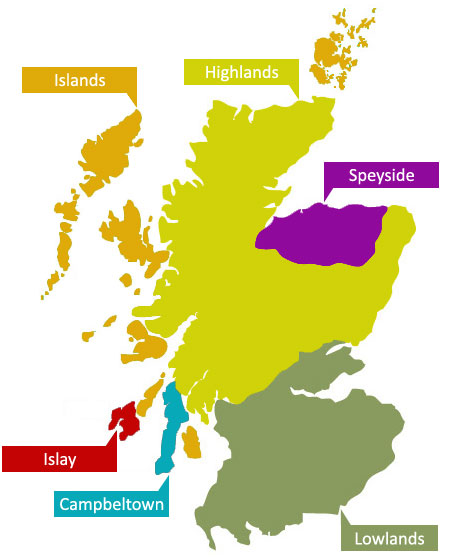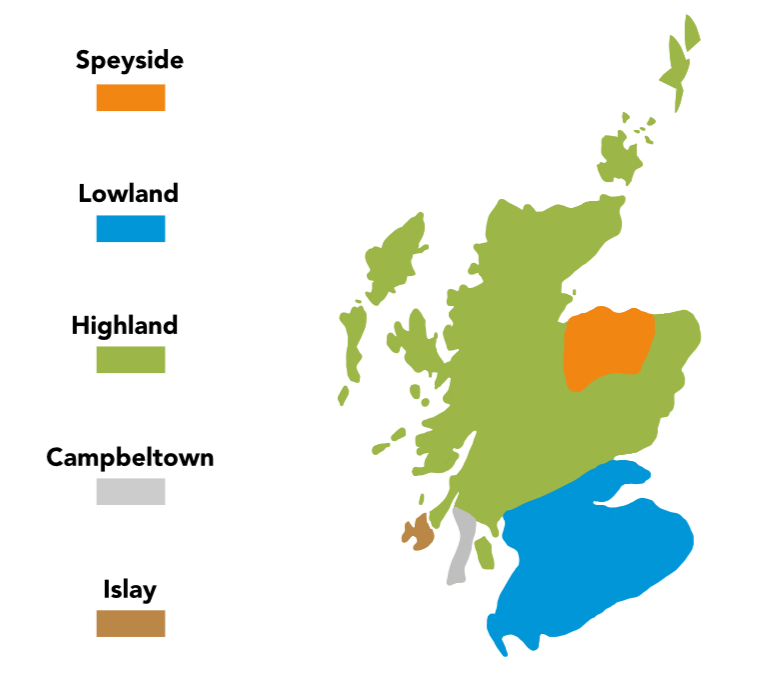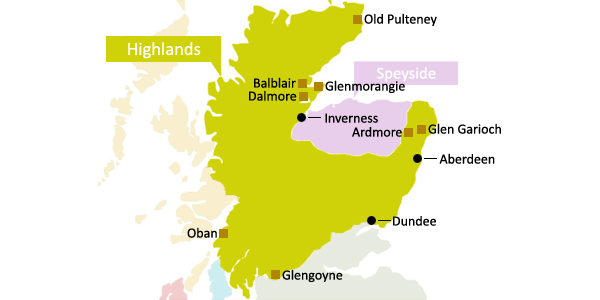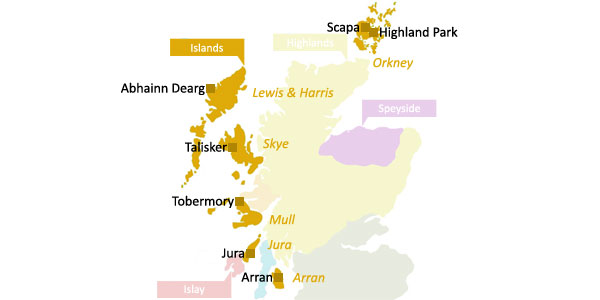Whiskey aficionados know that different regions across the globe have their own distinct methods of producing this beloved spirit, resulting in a wide variety of flavors and characteristics. From the peaty single malts of Scotland's Islay region to the smooth and complex bourbons of Kentucky, each whiskey-producing region leaves its own unique imprint on the final product. This article will take you on a fascinating journey through some of the renowned whiskey regions, exploring the nuances and differences that make each one truly special. So, grab a glass, sit back, and prepare to discover the beauty of whiskey diversity.

1. Introduction
Welcome to the world of whiskey! In this comprehensive article, we will explore the fascinating world of whiskey production and the regional variations that make each type unique. From the smoky depths of Scotch whisky to the smooth and subtle flavors of Australian whisky, we will delve into the rich history, production methods, and distinct qualities that define each style. So sit back, pour yourself a dram, and let's embark on this whiskey journey together!
2. Scotch Whisky
2.1 Overview
When the word "whisky" is mentioned, Scotch whisky is often the first thing that comes to mind. Known for its rich heritage and distinctive flavors, Scotch whisky hails from Scotland and is renowned worldwide. To be legally labeled as "Scotch whisky," it must be produced in Scotland and aged for a minimum of three years in oak casks. Scotch whisky is further categorized into five main types: Single Malt, Single Grain, Blended Malt, Blended Grain, and Blended Scotch Whisky. Each category brings its own unique characteristics to the table.
2.2 Production Process
The production process of Scotch whisky is a meticulous art that has been refined over centuries. It begins with malting, where barley is soaked in water and allowed to germinate. Then, the germinated barley is dried using peat smoke, which imparts the distinct smoky flavor often associated with Scotch whisky. The dried malt is then ground into a coarse powder called grist, which is mixed with hot water to extract the sugars and create a sweet liquid called wort. Yeast is added to ferment the wort, converting the sugars into alcohol. The resulting liquid, known as "wash," is then double-distilled in copper pot stills to create the spirit. Finally, the spirit is aged in oak casks, where it develops its complex flavors and deep amber color.
2.3 Regional Variations
Within Scotland, there are five distinct whisky regions, each with its own characteristics. The Highlands is the largest region and produces a wide variety of styles, from full-bodied and fruity to light and floral. Speyside, located within the Highlands, is known for its elegant and complex whiskies, often with a hint of sweetness. The Lowlands offer lighter and more delicate expressions, while Islay takes pride in producing heavily peated and smoky whiskies. Lastly, the Campbeltown region produces whiskies with a unique maritime influence, known for their briny and robust flavors.

3. Irish Whiskey
3.1 Overview
Irish whiskey holds a special place in the hearts of whiskey enthusiasts worldwide. Renowned for its smoothness and triple distillation process, Irish whiskey has a distinctive character that sets it apart from other styles. To be called "Irish whiskey," it must be produced in Ireland and aged for a minimum of three years in wooden casks. Irish whiskey is also known for its lighter and smoother profile compared to Scotch whisky.
3.2 Production Process
Unlike Scotch whisky, Irish whiskey typically uses unpeated barley during malting, resulting in a milder flavor profile. The production process begins with malting the barley, before mashing it with hot water to extract sugars. The sugars are then fermented with yeast to produce a liquid known as "wash." This wash is distilled three times in traditional copper pot stills, which contributes to its smoothness and character. After distillation, the whiskey is aged in oak casks, where it develops its unique flavors and mellowness.
3.3 Regional Variations
While Irish whiskey does not have officially recognized regional variations like Scotch whisky, there are subtle differences among distilleries. Bushmills, located in Northern Ireland, produces a light and fruity style of Irish whiskey. Midleton, in County Cork, is known for its smooth and complex expressions. Additionally, smaller distilleries are emerging, each offering their own distinctive character and flavor profiles. Irish whiskey embraces a wide range of styles, making it a versatile choice for whiskey enthusiasts.
4. American Whiskey
4.1 Overview
American whiskey brings a touch of history and tradition to the whiskey world. Made primarily from corn, American whiskey encompasses multiple styles, including Bourbon, Rye, and Tennessee whiskey. Each style has its own unique production methods and flavor profiles, making American whiskey a diverse and exciting category.
4.2 Production Process
The production process of American whiskey varies depending on the style. Bourbon, one of the most well-known types, must be made from a mash bill containing at least 51% corn and aged in newly charred oak barrels. Rye whiskey, on the other hand, requires a mash bill with at least 51% rye grain. Tennessee whiskey, similar to Bourbon, undergoes an additional charcoal filtering process known as the Lincoln County Process, which imparts a smooth and mellow character.
4.3 Regional Variations
The United States is the birthplace of various whiskey styles, each region adding its own twist to the production methods. Kentucky, often referred to as the "Bourbon Capital of the World," produces the majority of Bourbon whiskey. Tennessee is famous for its unique charcoal filtering process in the production of Tennessee whiskey. Other states, such as New York and Colorado, are also making names for themselves in the American whiskey scene by offering distinct and innovative expressions.

5. Canadian Whisky
5.1 Overview
Canadian whisky often flies under the radar, but it has a rich history and unique characteristics that deserve recognition. Made primarily from corn, Canadian whisky is known for its smoothness and versatility. While it may not have the same legal requirements as other whiskies, it still upholds a high standard of quality and craftsmanship.
5.2 Production Process
Canadian whisky is typically made from a blend of grains, including corn, rye, barley, and wheat. The grains are mashed, fermented, and distilled multiple times to create a clean and light spirit. One notable aspect of Canadian whisky production is the use of a high percentage of rye, which contributes to its distinct flavor profile. Following distillation, the whisky is aged in oak barrels to develop its flavors and complexity.
5.3 Regional Variations
Much like Irish whiskey, Canadian whisky does not have officially recognized regional variations. However, there are notable differences among producers. Canadian whiskies from Ontario are often characterized by their delicate and smooth profile, while those from Quebec may have more robust and spicier flavors. The wide range of distilleries across Canada ensures a diverse selection of Canadian whisky, appealing to a broad range of palates.
6. Japanese Whisky
6.1 Overview
Japanese whisky has skyrocketed in popularity in recent years, captivating whiskey enthusiasts worldwide with its precision and elegance. Drawing inspiration from Scotch whisky production methods, Japanese whisky has developed its own unique style and flavor profile, winning numerous awards and accolades on the global stage.
6.2 Production Process
Japanese distilleries closely follow the traditional Scotch whisky production process, which includes malting, mashing, fermentation, distillation, and aging. However, Japanese whisky distillers often incorporate their own techniques and twists, resulting in a distinct character. The use of different types of oak casks for aging, such as Mizunara oak, further adds to the complexity and uniqueness of Japanese whisky.
6.3 Regional Variations
While Japan does not have officially recognized whisky regions like Scotland, the country is home to several renowned distilleries, each with its own approach to whisky production. Distilleries such as Yamazaki and Nikka produce a wide range of whisky styles, from light and delicate to rich and peaty. Japanese whiskies are celebrated for their balance, precision, and attention to detail, making them a favorite among whisky connoisseurs.

7. Indian Whisky
7.1 Overview
India may not be the first country that comes to mind when thinking of whisky production, but it has its own flourishing whisky industry. Indian whisky is primarily made from molasses and often features a smooth and sweet flavor profile. Due to the warmer climate, Indian whisky tends to mature more quickly than whiskies produced in cooler regions.
7.2 Production Process
Indian whisky production involves the fermentation and distillation of molasses, a byproduct of sugar production, or a combination of grains. The spirit is then aged in oak barrels, where it matures and develops its flavors. The warmer climate accelerates the aging process, allowing Indian whiskies to achieve a similar level of maturity in a shorter period compared to whiskies produced in colder regions.
7.3 Regional Variations
India boasts a diverse whiskey landscape, with distilleries spread across the country. From the foothills of the Himalayas to the southern state of Kerala, each region in India brings something unique to its whisky production. Distilleries like Amrut and Paul John have gained international recognition for their exceptional whiskies, showcasing the potential of Indian whisky on the global stage.
8. Australian Whisky
8.1 Overview
Australia may be more commonly associated with wine production, but its whisky industry is rapidly gaining recognition. Australian whisky is known for its bold and innovative approach, incorporating local flavors and distilling techniques. This young and dynamic whisky scene is creating a buzz within the global whiskey community.
8.2 Production Process
Using locally sourced barley and often experimenting with climate and maturation techniques, Australian whisky embraces a unique production process. Distilleries take advantage of the country's diverse climate, aging whiskies in a range of cask types, including wine barrels that infuse the spirit with distinctive flavors. This experimental approach produces whiskies with a wide range of profiles, from fruity and vibrant to rich and smoky.
8.3 Regional Variations
Australia's vast landscape contributes to regional variations in whisky production. Tasmania, in particular, has emerged as the heart of Australian whisky production, with distilleries such as Sullivan's Cove and Lark leading the way. Tasmania's cooler climate and pristine water sources create ideal conditions for producing exceptional whiskies. Furthermore, distilleries in Victoria, New South Wales, and Western Australia are also making their mark, each adding their own distinct character to the Australian whisky scene.

9. Welsh Whisky
9.1 Overview
Welsh whisky may be lesser-known on the global stage, but its history and recent resurgence have solidified its position among whiskey enthusiasts. Welsh whisky has its roots in the early 18th century and has experienced a remarkable revival in recent years. Known for its smoothness and subtle flavors, Welsh whisky offers a unique whiskey experience.
9.2 Production Process
Welsh whisky production follows a similar process to Scotch whisky, emphasizing quality and tradition. The production begins with malted barley, which is mashed, fermented, and distilled using pot stills. The spirit is then aged in oak casks, allowing it to develop its character over time. Welsh distilleries pride themselves on using local ingredients, pure water sources, and traditional methods to create their distinctive whiskies.
9.3 Regional Variations
With only a handful of distilleries in Wales, the regional variations in Welsh whisky are not as pronounced as in other regions. However, each distillery brings its own unique approach and flavor profiles to the table. Distilleries such as Penderyn and Aber Falls create whiskies known for their delicate sweetness and smoothness, showcasing the potential of Welsh whisky on a global scale.
11. Conclusion
From the smoky depths of Scotch whisky to the delicate and smooth flavors of Irish whiskey, the world of whisky is a diverse and captivating realm. Each region known for its production of whiskey has a rich history, distinctive production methods, and regional variations that make their products unique. Whether you prefer the peaty notes of Islay, the smoothness of Irish whiskey, or the bold experimentation of Australian whisky, there is a whiskey style to suit every palate. So raise a glass and toast to the wide world of whiskey, a journey filled with endless exploration and appreciation of the craftsmanship behind each dram. Cheers!
